Application of Hydroxypropyl Methylcellulose in construction Materials
Hydroxypropyl Methylcellulose (HPMC) is a commonly used additive in the construction industry. It is a non-ionic, water-soluble cellulose ether that is derived from natural cellulose. HPMC is a highly versatile polymer that is used in various applications, including construction materials. In this article, we will discuss the application of HPMC in construction materials.
- Mortars and Plasters
HPMC is commonly used as a thickener, binder, and water-retaining agent in mortars and plasters. It improves the workability, adhesion, and durability of the mortar or plaster. HPMC also reduces the risk of cracking by improving the tensile strength of the mortar or plaster. The use of HPMC in mortars and plasters also reduces the amount of water required, which can lead to faster drying times and reduced shrinkage.
- Tile Adhesives
Tile adhesives are used to bond tiles to various surfaces. HPMC is commonly used as a thickener and water-retaining agent in tile adhesives. It improves the workability and open time of the adhesive, which allows the tiles to be adjusted before the adhesive sets. HPMC also improves the adhesion of the adhesive to the substrate and the tile, which reduces the risk of tile detachment.
- Self-Leveling Compounds
Self-leveling compounds are used to level uneven or sloping floors. HPMC is commonly used as a thickener and water-retaining agent in self-leveling compounds. It improves the flow and leveling properties of the compound, which allows it to spread evenly and create a smooth surface. HPMC also reduces the risk of cracking by improving the tensile strength of the compound.
- Exterior Insulation and Finishing Systems (EIFS)
EIFS is a type of exterior wall cladding system that is used to provide insulation and weather protection to buildings. HPMC is commonly used as a thickener and water-retaining agent in EIFS. It improves the workability of the EIFS, which allows it to be applied smoothly and evenly. HPMC also improves the adhesion of the EIFS to the substrate, which reduces the risk of detachment.
- Cement-based Renderings
Cement-based renderings are used to provide a decorative finish to walls and other surfaces. HPMC is commonly used as a thickener and water-retaining agent in cement-based renderings. It improves the workability of the rendering, which allows it to be applied smoothly and evenly. HPMC also improves the adhesion of the rendering to the substrate, which reduces the risk of detachment.
- Gypsum-based Products
Gypsum-based products, such as joint compounds and plasters, are used to provide a smooth and seamless finish to walls and ceilings. HPMC is commonly used as a thickener and water-retaining agent in gypsum-based products. It improves the workability of the product, which allows it to be applied smoothly and evenly. HPMC also improves the adhesion of the product to the substrate, which reduces the risk of detachment.
- Cement-based Adhesives
Cement-based adhesives are used to bond various materials, such as tiles, to substrates. HPMC is commonly used as a thickener and water-retaining agent in cement-based adhesives. It improves the workability of the adhesive, which allows it to be applied smoothly and evenly. HPMC also improves the adhesion of the adhesive to the substrate and the material being bonded, which reduces the risk of detachment.
- Coatings
Coatings, such as paints and sealants, are used to protect and decorate various surfaces. HPMC is commonly used as a thickener and water-retaining agent in coatings. It improves the workability and adhesion of the coating, which allows it to be applied smoothly and evenly. HPMC also improves the durability of the coating by reducing water absorption and improving resistance to weathering and abrasion.
In addition to the applications mentioned above, HPMC is also used in other construction materials, such as grouts, waterproofing membranes, and concrete additives. The use of HPMC in these materials improves their properties and performance, which enhances the overall quality and durability of the construction project.
One of the key advantages of using HPMC in construction materials is that it is a natural and sustainable material. HPMC is derived from renewable sources, such as wood pulp, and is biodegradable. It is also non-toxic and does not release harmful chemicals into the environment. As a result, the use of HPMC in construction materials supports the development of eco-friendly and sustainable construction practices.
In conclusion, Hydroxypropyl Methylcellulose (HPMC) is a highly versatile additive that is widely used in the construction industry. Its unique properties make it an ideal material for improving the workability, adhesion, and durability of various construction materials, such as mortars, plasters, tile adhesives, self-leveling compounds, EIFS, cement-based renderings, gypsum-based products, cement-based adhesives, and coatings. The use of HPMC in construction materials enhances their properties and performance, which leads to the development of high-quality and sustainable construction projects

Post time: Mar-14-2023
